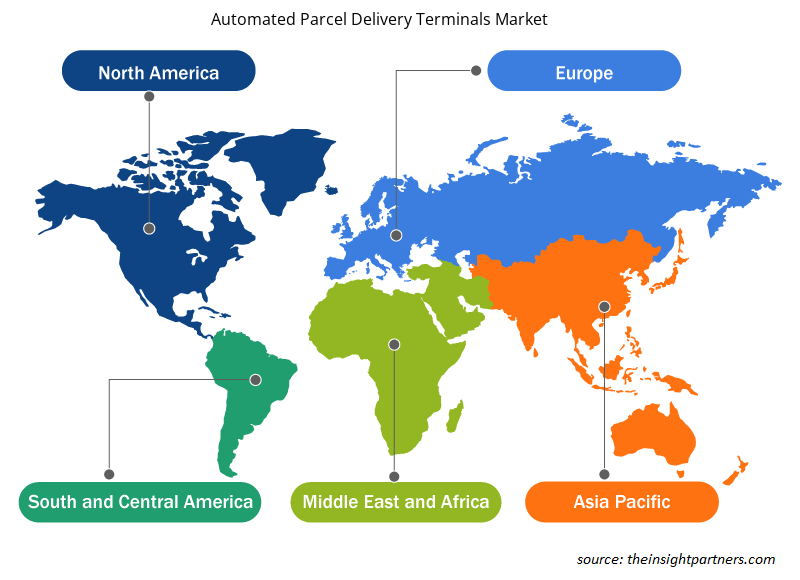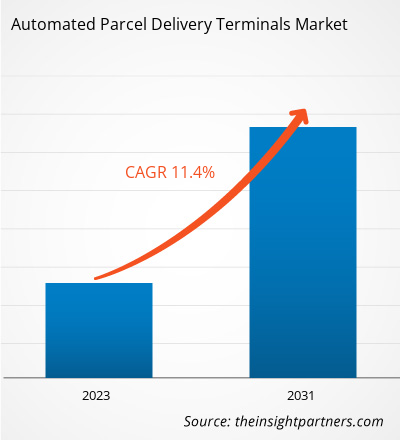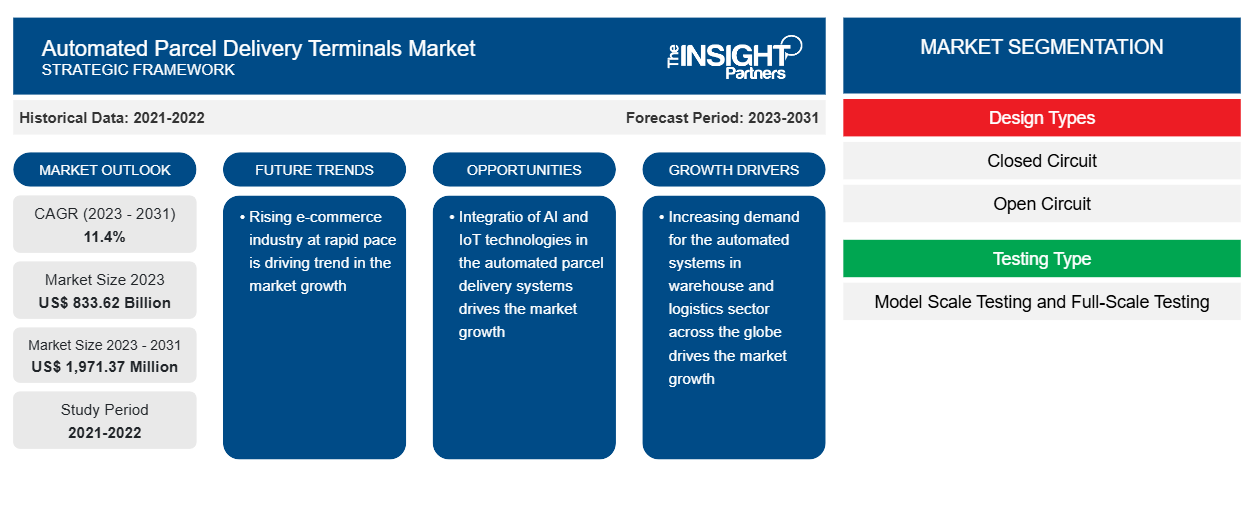Si prevede che il mercato dei terminali di consegna automatica dei pacchi raggiungerà 1.971,37 milioni di dollari entro il 2031, rispetto agli 833,62 miliardi di dollari del 2023. Si prevede che il mercato registrerà un CAGR dell'11,4% nel 2022-2031. I terminali di consegna automatica dei pacchi sono armadietti automatici con unità self-service progettati per semplificare le consegne dei pacchi. Questi terminali sono installati in luoghi ad alto traffico come centri commerciali, centri commerciali, negozi al dettaglio, supermercati, fermate degli autobus, aeroporti, stazioni ferroviarie e altre aree pubbliche. Lo scopo principale di questi terminali di consegna dei pacchi è quello di fornire un modo sicuro e conveniente per le persone di depositare e ritirare i pacchi in qualsiasi momento. Terminali di consegna automatica dei pacchi combinati con tecnologie avanzate progettate per soddisfare la crescente domanda del settore logistico e di stoccaggio.CAGR of 11.4% in 2022–2031. Automated parcel delivery terminals are the automated lockers with self-service units designed to streamline the parcel deliveries. These terminals are installed in high-traffic locations such as malls, shopping malls, retail stores, supermarkets, bus stands, airports, train stations, and other public areas. The main purpose of these parcel delivery terminals provide safe and convenient way for individuals to drop off and pick up packages at any time. Automated parcel delivery terminals combined with advanced technologies designed to meet growing logistics, and warehousing sector demand.
Analisi di mercato dei terminali di consegna automatica dei pacchi
Il mercato dei terminali di consegna automatica dei pacchi sta crescendo rapidamente a causa della crescente domanda dei consumatori di opzioni di consegna senza contatto e convenienti. Il progresso tecnologico per migliorare la produttività e i tempi di consegna dei consumatori ha portato a una domanda significativa per la crescita del mercato dei terminali di consegna automatica dei pacchi. Le tecnologie avanzate includono l'integrazione di AI e IoT per automatizzare le opzioni di consegna dei pacchi. I principali attori del mercato si stanno concentrando sulle innovazioni tecnologiche per risolvere i problemi relativi alla consegna dell'ultimo miglio. Un'ulteriore crescita del settore dell'e-commerce a un ritmo rapido con l'aumento delle tendenze dello shopping online ha creato una domanda enorme per la crescita del mercato dei terminali di consegna automatica dei pacchi durante il periodo di previsione.
Panoramica del mercato dei terminali di consegna automatica dei pacchi
La crescita crescente del settore dell'e-commerce con l'impennata degli acquisti online tra i consumatori in tutto il mondo ha creato una domanda enorme per la crescita del mercato dei terminali di consegna pacchi automatizzati durante il periodo di previsione. Secondo l'International Trade Administration Organization, si prevede che le vendite globali di e-commerce delle aziende B2B raggiungeranno un valore di 36 trilioni di dollari entro il 2026. Ciò è dovuto alle industrie pesanti come la produzione, l'assistenza sanitaria, l'energia e i segmenti dei servizi aziendali professionali che guidano la maggior parte della crescita del mercato. La crescente domanda di sistemi automatizzati nel settore dei magazzini e della logistica in tutto il mondo guida la crescita del mercato.
Personalizza questo report in base alle tue esigenze
Riceverai la personalizzazione gratuita di qualsiasi report, comprese parti di questo report, o analisi a livello nazionale, pacchetto dati Excel, oltre a usufruire di grandi offerte e sconti per start-up e università
- Scopri le principali tendenze di mercato in questo rapporto.Questo campione GRATUITO includerà analisi di dati che spaziano dalle tendenze di mercato alle stime e alle previsioni.
Driver di mercato e opportunità per i terminali di consegna automatica dei pacchi
La crescente domanda di sistemi automatizzati nel settore dei magazzini e della logistica in tutto il mondo guida la crescita del mercato
Il mercato è guidato dalla rapida crescita del settore dell'e-commerce, che ha creato una domanda massiccia per la crescita del mercato dei sistemi di consegna automatica dei pacchi. Ciò ha spinto la domanda di crescita del mercato dei terminali di consegna automatica dei pacchi.
Inoltre, fattori come le consegne in aree remote e i tentativi di consegna falliti sono responsabili di costi aggiuntivi per le aziende. Di conseguenza, le soluzioni di self-pickup come i terminali di consegna automatica dei pacchi stanno guadagnando popolarità tra i rivenditori di e-commerce.
L'adozione mondiale di telefoni cellulari e accesso a Internet ha reso possibile per i consumatori acquistare beni da altri paesi. Si prevede che il numero di spedizioni di pacchi aumenterà in modo significativo come risultato di ciò. I rivenditori stanno anche evidenziando l'uso di opzioni di consegna di pacchi alternative per prevenire consegne fallite o in ritardo.
I governi di tutto il mondo stanno ponendo molta enfasi sulla digitalizzazione e incoraggiando i pagamenti senza contanti, in particolare nei paesi in via di sviluppo come Cina e India. I governi possono promuovere i loro obiettivi politici di un'economia digitalizzata, senza contanti e più trasparente utilizzando l'opzione Contrassegno (COD) presente nei terminali di consegna pacchi intelligenti, che facilita transazioni di successo e senza interruzioni tra clienti e consumatori.
La crescente adozione di tecnologie avanzate come l'apprendimento automatico, l'intelligenza artificiale, l'Internet delle cose e la blockchain sta stimolando la crescita del mercato.
La crescente integrazione di tecnologie avanzate come l'apprendimento automatico, l'intelligenza artificiale e l'Internet delle cose per lanciare terminali automatici per pacchi sta creando notevoli opportunità nel mercato. Diversi attori chiave nel mercato stanno sviluppando e lanciando tecnologie avanzate basate su terminali automatici per la consegna dei pacchi. Ad esempio, a novembre 2023, Oman Post, sussidiaria del Gruppo Asyad, ha lanciato un'innovativa macchina terminale automatica per pacchi. La tecnologia avanzata all'avanguardia ha contribuito al miglioramento del 43% dell'efficienza operativa che a sua volta migliora la soddisfazione del cliente. Il sistema implementato con tecnologia AI per migliorare la produttività e aumentare l'efficienza della consegna dei pacchi ai clienti. Questo terminale basato sull'AI gestisce fino a 6.000 pacchi all'ora, smista più di 12 linee per esecuzione.
Analisi della segmentazione del rapporto di mercato sui terminali di consegna automatica dei pacchi
I segmenti chiave che hanno contribuito alla derivazione dell'analisi di mercato dei terminali per la consegna automatizzata dei pacchi sono i fornitori di servizi e di distribuzione.
- In base all'impiego, il mercato si divide in indoor e outdoor.
- In base agli utenti finali, il mercato è suddiviso in rivenditori/e-commerce, spedizioni/logistica, magazzini, governo e altri.
Analisi della quota di mercato dei terminali di consegna automatica dei pacchi per area geografica
L'ambito geografico del rapporto di mercato sui terminali di consegna automatica dei pacchi è suddiviso principalmente in cinque regioni: Nord America, Europa, Asia Pacifico, Medio Oriente e Africa e Sud America.
Si prevede che il Nord America dominerà la crescita del mercato grazie al rapido ritmo di adozione di tecnologie avanzate basate su terminali di consegna pacchi automatizzati. Gli Stati Uniti e il Canada detengono quote significative nel mercato globale con investimenti crescenti nell'automazione dei magazzini da parte delle principali aziende di logistica negli Stati Uniti.
Tuttavia, c'è una significativa opportunità nelle nazioni in via di sviluppo nella regione Asia-Pacifico di adottare terminali di consegna pacchi automatizzati a causa della crescita del settore dell'e-commerce in tutto il mondo. India e Cina sono le nazioni in più rapida crescita nell'adozione di terminali di consegna pacchi automatizzati. Diversi fornitori leader di servizi logistici stanno investendo una quantità significativa nell'acquisto di terminali di consegna pacchi automatizzati per soddisfare la crescente domanda del settore logistico.
Approfondimenti regionali sul mercato dei terminali di consegna automatica dei pacchi
Le tendenze regionali e i fattori che influenzano il mercato dei terminali di consegna automatica dei pacchi durante il periodo di previsione sono stati ampiamente spiegati dagli analisti di Insight Partners. Questa sezione discute anche i segmenti di mercato dei terminali di consegna automatica dei pacchi e la geografia in Nord America, Europa, Asia Pacifico, Medio Oriente e Africa e America meridionale e centrale.

- Ottieni i dati specifici regionali per il mercato dei terminali di consegna automatica dei pacchi
Ambito del rapporto di mercato sui terminali di consegna automatica dei pacchi
| Attributo del report | Dettagli |
|---|---|
| Dimensioni del mercato nel 2023 | 833,62 miliardi di dollari USA |
| Dimensioni del mercato entro il 2031 | 1.971,37 milioni di dollari USA |
| CAGR globale (2023-2031) | 11,4% |
| Dati storici | 2021-2022 |
| Periodo di previsione | 2023-2031 |
| Segmenti coperti | Per tipi di progettazione
|
| Regioni e Paesi coperti | America del Nord
|
| Leader di mercato e profili aziendali chiave |
|
Densità degli attori del mercato: comprendere il suo impatto sulle dinamiche aziendali
Il mercato dei terminali di consegna automatica dei pacchi sta crescendo rapidamente, spinto dalla crescente domanda degli utenti finali dovuta a fattori quali l'evoluzione delle preferenze dei consumatori, i progressi tecnologici e una maggiore consapevolezza dei vantaggi del prodotto. Con l'aumento della domanda, le aziende stanno ampliando le loro offerte, innovando per soddisfare le esigenze dei consumatori e capitalizzando sulle tendenze emergenti, il che alimenta ulteriormente la crescita del mercato.
La densità degli operatori di mercato si riferisce alla distribuzione di aziende o società che operano in un particolare mercato o settore. Indica quanti concorrenti (operatori di mercato) sono presenti in un dato spazio di mercato in relazione alle sue dimensioni o al valore di mercato totale.
Le principali aziende che operano nel mercato dei terminali per la consegna automatica dei pacchi sono:
- Soluzioni di e-commerce Smartbox Pvt. Ltd.
- Cleveron come
- Gruppo NeoPost
- Società anonima Winnsen Industry Co., Ltd.
- TZ limitata
- Società per azioni ByBox Holdings Limited
Disclaimer : le aziende elencate sopra non sono classificate secondo un ordine particolare.

- Ottieni una panoramica dei principali attori del mercato dei terminali di consegna automatica dei pacchi
Terminali di consegna automatica dei pacchi: notizie di mercato e sviluppi recenti
Il mercato dei terminali di consegna automatica dei pacchi viene valutato raccogliendo dati qualitativi e quantitativi dopo la ricerca primaria e secondaria, che include importanti pubblicazioni aziendali, dati di associazioni e database. Di seguito è riportato un elenco degli sviluppi nel mercato per il mercato e le strategie dei terminali di consegna automatica dei pacchi:
- Ad aprile 2021, Cleveron, azienda di robotica per la consegna dei pacchi, ha lanciato il veicolo semi-autonomo per la consegna dell'ultimo miglio Cleveron 701. È progettato per migliorare la produttività e l'efficienza delle aziende di logistica e vendita al dettaglio per potenziare le consegne dell'ultimo miglio dei pacchi. (Fonte: Flyability, comunicato stampa/sito Web aziendale/newsletter)
Copertura e risultati del rapporto di mercato sui terminali di consegna automatica dei pacchi
Il rapporto "Dimensioni e previsioni del mercato dei terminali di consegna automatica dei pacchi (2021-2031)" fornisce un'analisi dettagliata del mercato che copre le seguenti aree:
- Dimensioni e previsioni del mercato a livello globale, regionale e nazionale per tutti i segmenti di mercato chiave coperti dall'ambito
- Dinamiche di mercato come fattori trainanti, vincoli e opportunità chiave
- Principali tendenze future
- Analisi dettagliata delle cinque forze di Porter
- Analisi di mercato globale e regionale che copre le principali tendenze di mercato, i principali attori, le normative e gli sviluppi recenti del mercato
- Analisi del panorama industriale e della concorrenza che copre la concentrazione del mercato, l'analisi della mappa di calore, i principali attori e gli sviluppi recenti
- Profili aziendali dettagliati con analisi SWOT
- Analisi storica (2 anni), anno base, previsione (7 anni) con CAGR
- Analisi PEST e SWOT
- Valore/volume delle dimensioni del mercato - Globale, Regionale, Nazionale
- Industria e panorama competitivo
- Set di dati Excel
Report recenti
Testimonianze
Motivo dell'acquisto
- Processo decisionale informato
- Comprensione delle dinamiche di mercato
- Analisi competitiva
- Analisi dei clienti
- Previsioni di mercato
- Mitigazione del rischio
- Pianificazione strategica
- Giustificazione degli investimenti
- Identificazione dei mercati emergenti
- Miglioramento delle strategie di marketing
- Aumento dell'efficienza operativa
- Allineamento alle tendenze normative























 Ottieni un campione gratuito per - Mercato dei terminali di consegna automatica dei pacchi
Ottieni un campione gratuito per - Mercato dei terminali di consegna automatica dei pacchi